 The Kenyan shilling has this week shown a remarkable recovery, experiencing its fastest appreciation against the US dollar in three years.
The Kenyan shilling has this week shown a remarkable recovery, experiencing its fastest appreciation against the US dollar in three years.
On Tuesday, the shilling gained 0.73 percent in value, trading at 160.19 compared to 161.36 on Monday, breaking away from a long-standing depreciation trend.
Although we should not read much into it, this shift marks a significant deviation from the shilling’s previous performance.
Last year, the Kenyan currency depreciated by over 26 percent against the dollar, which means even big single-day gains like this one will barely cover it.
The last time the shilling saw similar gains was during the Covid-19 pandemic on December 23, 2020, when it added 1.46 percentage value against the dollar, strengthening to 109.44 from 111.04.
The shilling’s recent trend indicates a possible stabilization.
Over the past nine days, the shilling has posted gains on five occasions, contrasting sharply with its earlier pattern of almost consistent daily losses.
Muathi Kilonzo from EFG Hermes stated, If you are getting days of strengthening, then that begins telling you that the market is improving. It is a positive sign and shows that liquidity may be returning to the interbank forex market.
The Central Bank of Kenya’s (CBK) average rates closely match the buy/sell rates quoted by banks. For instance, Equity Bank quoted the dollar at Sh164 selling and Sh158.5 buying, while I&M Bank’s rates were Sh166.9 selling and Sh161.9 buying.
CBK Governor Kamau Thugge has previously noted that the shilling had been overvalued by up to 25 percent.
The shilling’s depreciation rate over the past year exceeded three times the 8.3 percent devaluation seen in 2022. The currency’s decline last year was the steepest in 30 years since 1993.
Experts warn against interpreting this as a definitive reversal of the shilling’s decline, instead attributing the slowdown in depreciation more to regulatory interventions than market dynamics.
The consensus is that the shilling’s depreciation will continue through the year due to factors like high energy import demand and shrinking export inflows.
A rebound in the shilling’s value would relieve importers and foreign currency borrowers, but could negatively impact expatriates, locals with dollar incomes, exporters, and recipients of diaspora remittances.
Additionally, it could help contain the growth of dollar-denominated public debt, which expanded by Sh65 billion in the year to June 2023.








